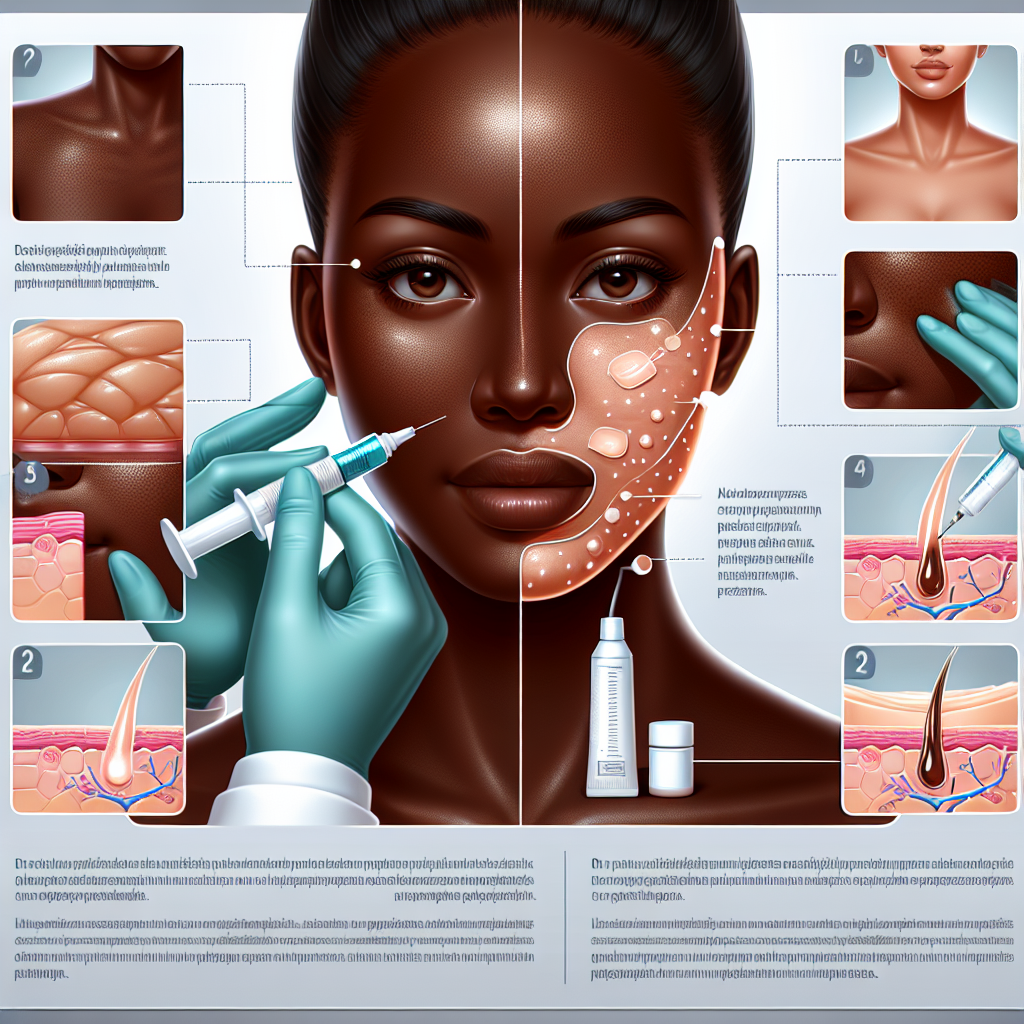
When it comes to managing scars on dark skin, chemical peels can be a game-changer. However, it’s essential to understand the nuances of these treatments to ensure safety and effectiveness. With the right approach, chemical peels can reduce the appearance of scars, leaving skin looking healthier and more even.
- Chemical peels can effectively manage scars on dark skin when tailored to individual needs.
- Understanding the types of peels and their specific uses is crucial for safety and results.
- Superficial peels are mild and suitable for minor blemishes and discoloration.
- Medium-depth peels target deeper skin issues, such as more pronounced scarring.
- Deep peels are not recommended for dark skin due to the risk of discoloration.
The Quest for Clear Skin: Understanding Chemical Peels for Dark Skin Tones

Defining Chemical Peels and Their Purpose
Chemical peels are treatments that use a solution applied to the skin to remove dead cells and stimulate the growth of new, healthier skin. They can address various concerns, including acne scars, hyperpigmentation, and uneven skin texture. The purpose of a peel is to improve the skin’s appearance by reducing imperfections.
Unique Considerations for Dark Skin
Dark skin has more melanin, which provides natural protection against the sun but also poses unique challenges. Chemical peels must be chosen carefully to prevent hyperpigmentation, or dark spots, which can occur if the skin is irritated or inflamed. Therefore, it’s important to select peels that are appropriate for the skin’s sensitivity and pigment level.
Common Types of Scars Addressed by Peels
Chemical peels can address various types of scars on dark skin:
- Post-inflammatory hyperpigmentation (PIH), which appears as dark spots after acne or injury.
- Atrophic scars, which are indented scars that occur when the skin cannot regenerate tissue.
- Hypertrophic scars and keloids, which are raised scars that can be more common in dark skin.
Choosing the Right Peel: Options for Dark Skin

Superficial Peels: Mild but Effective
Superficial peels are a gentle option for managing minor scars and discoloration. They typically use mild acids like glycolic or lactic acid and have minimal downtime. These peels are ideal for individuals looking to brighten their complexion without significant peeling or recovery time.
Medium-depth Peels: Targeting Deeper Issues
For more pronounced scarring, medium-depth peels penetrate further into the skin. They can address deeper pigment issues and smooth out the skin’s texture. Ingredients like trichloroacetic acid (TCA) are commonly used, but these peels require more recovery time and must be performed by a professional.
Deep Peels: When to Use Them
Deep peels are the most intense and penetrate down to the lower dermal layers of the skin. They are typically not recommended for dark skin due to the high risk of causing permanent discoloration or scarring. Instead, it’s better to opt for a series of milder peels over time to achieve similar results without the risks.
Monitoring the Skin’s Response
After a chemical peel, it’s vital to observe how your skin reacts. Mild redness and peeling are normal, but any signs of severe irritation or discomfort should be reported to your skincare professional immediately. They will guide you on whether these reactions are part of the normal healing process or if they require additional care.
Duration and Frequency of Treatments
The number of treatments you’ll need depends on the type of peel and the severity of your scars. Superficial peels can be done more frequently, sometimes every four to six weeks, while medium-depth peels may be spaced out every few months. Your skincare provider will develop a plan tailored to your skin’s needs and the desired outcome.
Post-Peel Care: Ensuring the Best Outcome for Dark Skin
Proper aftercare is crucial for the success of your chemical peel, especially for dark skin, which is more prone to pigmentation changes. Following your skincare professional’s instructions will help you achieve the best results and minimize potential side effects.
Immediate Aftercare Instructions
Right after your peel, your skin will be sensitive. It’s important to:
-
Avoid direct sunlight and always wear a broad-spectrum sunscreen.
-
Keep your skin hydrated with gentle, non-irritating moisturizers.
-
Refrain from picking or peeling any flaking skin to prevent scarring.
Additionally, you should avoid using any harsh products or exfoliants until your skin has fully healed.
Tips to Minimize Side Effects and Promote Healing
To reduce the risk of side effects and promote healing:
-
Use a gentle cleanser to keep the skin clean without causing irritation.
-
Apply any post-peel treatments or serums recommended by your skincare provider to support the healing process.
-
Stay hydrated and maintain a healthy diet to support skin regeneration.
Long-term Skincare Post Peel
After your skin has healed, maintain a skincare routine that includes daily sunscreen, moisturizer, and gentle cleansing. This will not only help preserve the results of your peel but also protect your skin from future damage.
The Results Speak: Assessing Improvement in Scars
Chemical peels can significantly improve the appearance of scars over time. After a series of treatments, you should notice your scars becoming less visible, and your overall skin tone more even. It’s important to take before-and-after photos to objectively assess the improvement.
Short-term Versus Long-term Results
Initially, you may see immediate brightening, but true scar improvement will be more gradual. Superficial peels offer quicker recovery but may require multiple sessions for noticeable results. Medium-depth peels may show more significant changes in scar appearance but come with longer recovery periods.
Managing Expectations and When to Seek Further Treatment
Set realistic expectations and understand that while chemical peels can improve the appearance of scars, they may not completely remove them. If your scars are not responding as expected, it may be time to consult your skincare provider about alternative treatments or a revised approach.
Success Stories: Real Results from Tailored Chemical Peels
Many individuals with dark skin have seen transformative results from chemical peels. For instance, a patient with acne scars underwent a series of medium-depth peels and saw a significant reduction in scarring and a smoother skin texture.
Common Questions and Myths About Chemical Peels for Dark Skin
There are several misconceptions about chemical peels for dark skin. Let’s address some common questions and bust a few myths.
Can All Types of Scars Be Treated with a Chemical Peel?
While chemical peels can improve many types of scars, they may not be effective for all. Deep or very severe scars might require different treatments, such as laser therapy or microneedling.
Is There a Risk of Skin Lightening?
When performed correctly, chemical peels should not lighten dark skin. However, there is a risk of hypopigmentation if the peel is too strong or if aftercare instructions are not followed properly. Always work with a qualified professional who has experience with dark skin.
Your Action Plan for Scar Management
To manage scars on dark skin with chemical peels, start by consulting a skincare professional experienced in treating dark skin. Together, you can determine the most suitable type of peel for your skin concerns. Remember, patience and consistency are key, as multiple treatments may be needed to achieve desired results. Follow all aftercare instructions diligently, and maintain a gentle skincare routine to support healing and protect your skin.
Connecting with the Right Skincare Professional
Finding a skilled professional who understands the nuances of dark skin is critical. Look for a licensed dermatologist or esthetician with a proven track record of treating dark skin tones. They should provide a thorough skin assessment, discuss your goals, and create a personalized treatment plan. Trust and clear communication with your skincare provider will enhance your experience and outcomes.
Continuing Your Skin Health Journey
Managing scars is just one part of your overall skin health journey. Continue to educate yourself on skincare, and stay up-to-date with the latest treatments and products suitable for dark skin. Embrace a healthy lifestyle, as good nutrition and hydration can positively impact your skin’s appearance and healing capacity. Lastly, celebrate every improvement and be proud of taking steps to care for your skin.
Frequently Asked Questions (FAQ)
1. What Makes Chemical Peels Suitable for Dark Skin Types?
Chemical peels are suitable for dark skin types when they are correctly chosen and applied. Superficial and medium-depth peels that use mild acids can improve the skin’s appearance without causing excessive irritation or pigmentation issues. It’s all about selecting the right peel and following a customized treatment plan.
2. How Often Can I Have a Chemical Peel?
The frequency of chemical peels depends on the type of peel and your skin’s response. Superficial peels can be done every four to six weeks, while medium-depth peels may be spaced out every few months. Your skincare professional will recommend a schedule that’s safe and effective for your skin’s needs.
3. Are Chemical Peels Painful?
Chemical peels can cause a tingling or burning sensation during the application, but they should not be painful. Your skincare provider will take steps to ensure your comfort throughout the process. Any discomfort should subside shortly after the peel is neutralized or removed.
4. How Many Treatments Will I Need to See Results?
The number of treatments needed varies based on the type of scars, the peel used, and your skin’s reaction. While some improvements may be visible after a single treatment, multiple sessions are often necessary to achieve significant results. Your skincare professional will guide you on the expected number of treatments for your specific situation.
5. What Should I Avoid After a Chemical Peel?
After a chemical peel, you should avoid:
-
Direct sun exposure and ensure you use a broad-spectrum sunscreen daily.
-
Using harsh skincare products or exfoliants until your skin has fully healed.
-
Picking or peeling flaking skin to prevent potential scarring.
Additionally, avoid strenuous exercise and anything that may excessively heat the skin for the first few days after the peel.


